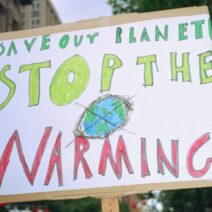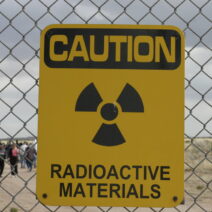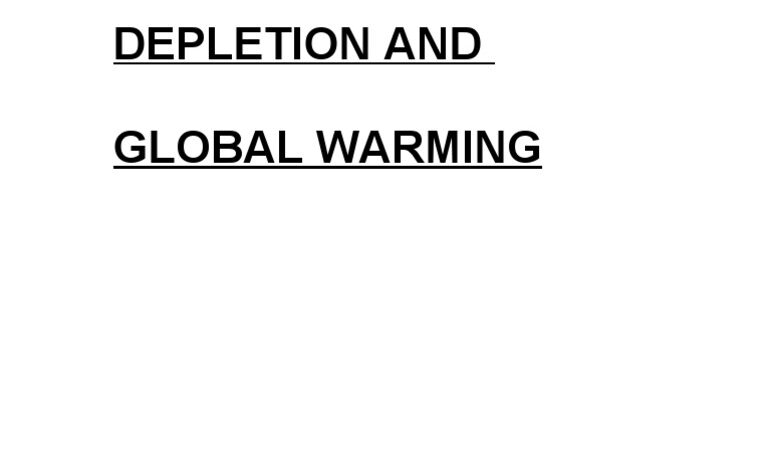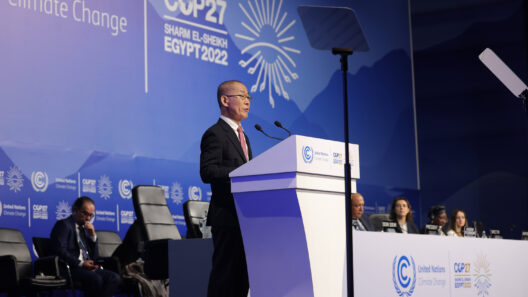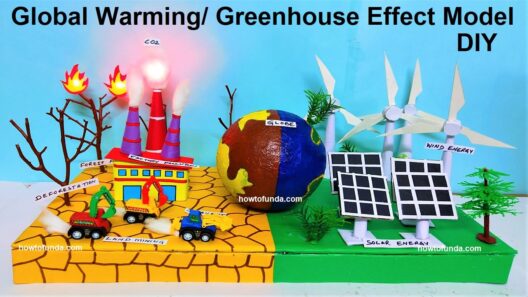The ozone layer, often regarded as Earth’s celestial shield, serves as a barrier against the sun’s most harmful ultraviolet (UV) radiation. It can be likened to an invisible shield, protecting our biosphere from the incursion of high-energy photons that possess enough energy to shred molecular structures apart. However, the relentless rise of certain anthropogenic chemicals has destabilized this protective layer, leading to its depletion. This depletion not only affects the immediate health of living organisms but inadvertently contributes to the broader and graver phenomenon of global warming.
To grasp the intricacies of how ozone layer depletion influences global warming, one must first delve into the chemistry of the atmosphere. The ozone layer is primarily composed of ozone (O3), a triatomic molecule resulting from the interaction between molecular oxygen (O2) and UV light. As certain chemicals, notably chlorofluorocarbons (CFCs), rise into the stratosphere, they are broken down by UV radiation, releasing chlorine atoms that catalyze the destruction of ozone molecules. With an increased incidence of UV radiation reaching Earth’s surface due to this depletion, we witness a cascading effect that disrupts equilibrium—much like a carefully stacked set of dominoes collapsing one after another.
One might ask, how does the destruction of ozone translate to global warming? The answer lies in the nuanced relationship between heat retention and atmospheric composition. As the ozone layer weakens, its ability to filter solar radiation dwindles. Consequently, more UV radiation penetrates the atmosphere. This heightened exposure generates an increase in atmospheric temperatures. Imagine a greenhouse effect, magnified—a thermal blanket enveloping the Earth, trapping heat that would otherwise escape back into space.
Further complicating this precarious balance is the production of greenhouse gases. As UV rays penetrate the weakened ozone layer, they foster conditions conducive to the proliferation of these gases, such as carbon dioxide (CO2) and methane (CH4). This rise is not merely coincidental but synergistic. For instance, the heightened temperatures from increased UV radiation can enhance the rate of decomposition of organic matter, subsequently releasing more CO2 into the atmosphere. One could envision this relationship as a ferocious predator and its prey; with each interaction intensifying the situation.
Moreover, the biological ramifications of increased UV exposure are significant. The ecological consequences of ozone depletion manifest as a rise in skin cancers and cataracts among living organisms, including humans, as well as detrimental impacts on phytoplankton populations in oceans. Phytoplankton forms the foundation of aquatic food webs. Their reduction can disrupt the entire marine ecosystem, leading to decreased carbon sequestration, explaining how the health of our oceans is inextricably linked to the ozone layer. If the oceans suffer, so too does the atmosphere, contributing to the vicious cycle of warming.
Following the exposure of the Earth’s surface to more intense UV radiation, it becomes evident that flora and fauna adapt in unexpected ways. Plants, often seen as the lungs of the Earth, may initially seem to benefit from increased solar radiation. However, prolonged UV exposure can impair photosynthesis, stunting growth and reducing biomass. The once verdant landscapes may yield to arid conditions, sealing their fate in an ongoing battle against the encroaching heat. This dynamic mirrors the struggle of a flame fighting the inevitable suffocation of its own smoke.
The implications extend beyond immediate biological variables. The alteration of climatic patterns due to ozone thinning exhibits further consequences on weather systems, leading to erratic temperature fluctuations and precipitation changes. These shifts are akin to the unpredictable whims of a tempest, capable of wreaking havoc on agricultural practices and food security far beyond the immediate vicinity of the ozone holes.
Addressing ozone depletion and global warming necessitates a multifaceted approach. International treaties, such as the Montreal Protocol, demonstrate that global collective action can indeed yield positive results. By phasing out the use of CFCs and other ozone-depleting substances, we witness a restoration of the ozone layer, albeit slowly. However, while simultaneously targeting greenhouse gas emissions, one must aim for a concerted effort to mitigate climate change holistically—a formidable challenge akin to steering a colossal ship through tumultuous waters towards a serene harbor.
Furthermore, fostering public awareness about the link between ozone depletion and global warming is paramount. The narrative must evolve beyond scientific jargon; it should resonate with the wider population, eliciting emotional responses that cultivate a global consciousness. Advocacy must emphasize the idea that safeguarding the ozone layer is not merely an environmental luxury, but a necessity for the survival of life as we know it.
In summary, the depletion of the ozone layer is far more than an isolated issue; it intricately weaves into the broader tapestry of global warming. Each thread represents a consequence, a reaction echoing throughout the atmosphere, our ecosystems, and ultimately, our societal structure. The metaphor of a decaying shield against a relentless sun serves as a poignant reminder of our precarious situation. To reflect upon these interconnections is to understand that our actions today will reverberate through generations. The battle for a healthier planet hinges upon our collective will to nurture this elusive shield and, by extension, our climate. The time for reflection and action is now.
